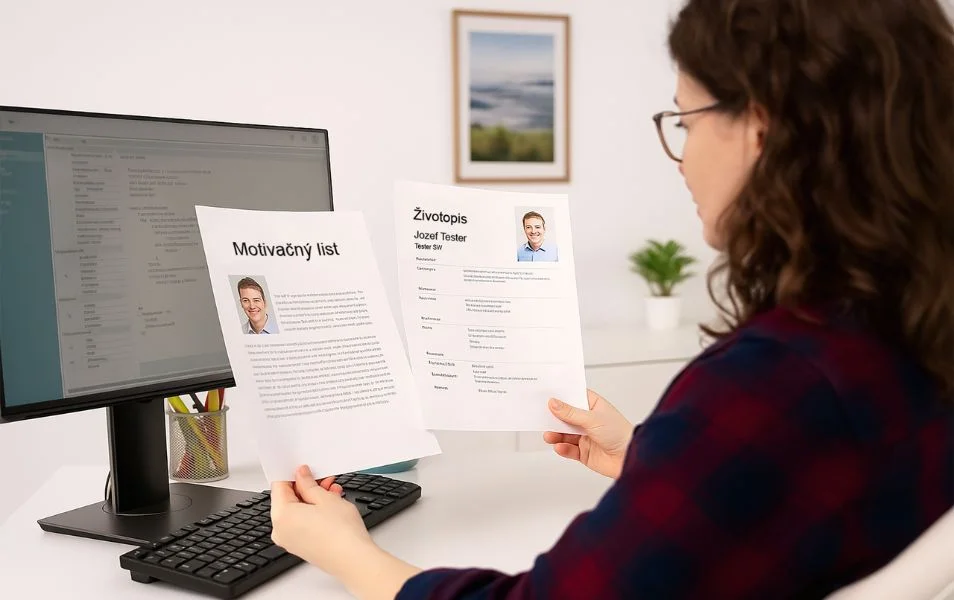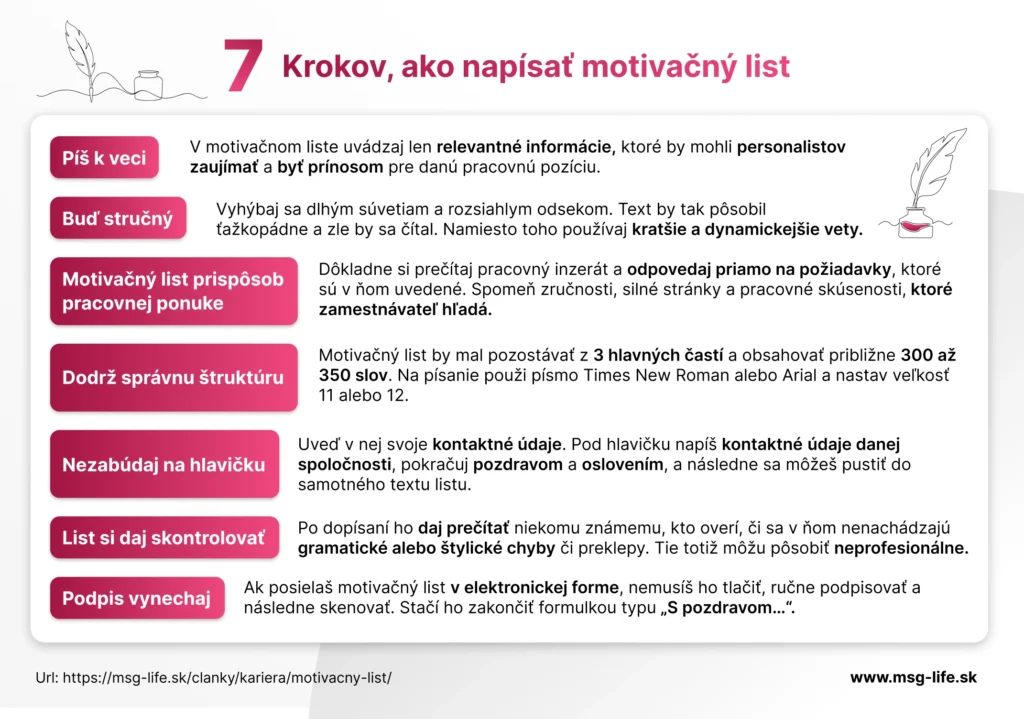How to write a simple cover letter for job application + cover letter example
A cover letter is one of the key documents used to introduce yourself to a potential employer. Unlike a CV, it provides additional information about you and your skills. While writing a cover letter is not difficult, it is important to know what information to include and what to avoid. We have prepared all the essential information for you, along with practical tips to help you make a good first impression.

In the article you will learn:
Cover letter meaning
A cover letter introduces you to the people who will decide whether to hire you. This additional text accompanies a CV and enables job applicants to highlight their motivations, skills, and interest in a particular role. It also gives applicants the opportunity to present their experience and aspirations for the role. When writing a cover letter, it is important to be concise yet persuasive — the aim is to demonstrate why you are the ideal candidate.
A cover letter is more personal than a CV. It gives you the opportunity to share more information about yourself and your personality. However, it’s not just about the content — the structure and style of your letter are also important. Although it is just a text document, you can still make it original.
Short cover letters containing short sentences or bullet points can indicate to a recruiter that you have an analytical mindset. Conversely, a slightly more comprehensive writing style can demonstrate your creativity.
A cover letter is not compulsory when applying for a job. Many companies do not require one in the first round of the selection process due to time constraints. If it is not mentioned in the job advertisement, you do not need to send one. Only do so if the company specifically asks for it, or if you are invited to the next stage of the process by the HR department.
How to write a cover letter?
While a CV describes your past work experience, a cover letter demonstrates how your skills and knowledge are relevant to the position you are applying for. A well-written cover letter will make a recruiter want to read your CV.
Tailor your cover letter to the position you are applying for
Write a cover letter for a particular job offer. Read the job advert carefully so that you can respond directly to the requirements listed in it. This demonstrates to the employer that you are genuinely interested in the job, rather than just sending out a generic document to several companies.
Follow the cover letter structure
Most companies prefer a simple cover letter. Stick to a clear structure and avoid overdoing it – whether in content, length, or email design. A clean document with black text (no italics or bolding) is ideal. Divide the information into paragraphs and use shorter, concise sentences rather than complex phrasing.
Stay on topic
If you’re wondering how to write a cover letter, the answer is simple – focus on relevant information. Avoid information that may not be interesting or useful to the employer. This not only makes you look professional but also shows that you’ve studied the job posting and understand the company’s needs.
Mind the proper structure
A cover letter should be divided into three basic sections, no longer than one A4 page (about 300–350 words). Use classic fonts like Times New Roman or Arial in size 11 or 12. Don’t forget margins—ideally 1 to 1.5 cm. Send the finished cover letter as a PDF attachment.
Don’t forget the header
Every cover letter should include a header with your personal and contact details, followed by the recipient’s (the company’s) contact information. Next comes the salutation, the body of the letter, and a closing (e.g., „Sincerely…“).
Watch your grammar and typos
A cover letter represents your skills and abilities to recruiters. To make the best impression, proofread the text multiple times and have someone else review it—even a close friend might catch mistakes you’ve missed.
A signature is not necessary
Cover letters are usually sent electronically via email, so a handwritten signature isn’t required. Simply end with „Sincerely…“ followed by your name.
As mentioned earlier, a cover letter serves as a supplement to a resume, highlighting the applicant’s personal and professional goals, ambitions, and values. It can also include information beyond a direct summary of work experience, such as personal and professional development plans or a commitment to continuous skill improvement.
How to write an application letter for a CV
An application letter is a document that accompanies a CV and provides additional space for personal introduction and justification of your interest in a particular job or company. An application letter template may be similar to a cover letter template.
The purpose and key elements of a cover letter may include the following:
- Grab attention: The application letter aims to engage the recruiter or employer and convince them you’re the right candidate.
- Complement the CV: It offers space for details that didn’t fit in the CV, such as personal motivations, goals, or relevant experiences.
Cover letter and application letter
A cover letter is sometimes incorrectly referred to as an application letter for a CV. However, they are two different documents.
Cover letters are usually longer, typically around 300–350 words. They are usually written in regular paragraphs, though bullet points are sometimes used. They provide more information about your skills, experience and interests. It is not always attached to your CV – many companies do not require it at the initial stage of the selection process.
On the other hand, the application letter is much shorter – usually just a few sentences. It directly responds to the job posting and typically includes:
- A greeting
- An address
- The reason for your interest in the position
- A note that you’ve attached your CV and any other documents
The application letter template is very simple. You don’t write it as a separate document but directly in the body of the email or in the web form where you found the job posting.
What cover letter looks like – cover letter sample
At first glance, a cover letter appears to be a simple document you can write in a few minutes. While writing it isn’t generally difficult, you should always set aside enough time to include all the necessary information.
A cover letter template usually consists of several sections. The first is the salutation. This is followed by the body of the document, which is divided into three parts, and finally comes the closing and sign-off.
To make writing easier, we’ve broken down each section in detail:

Directly address the contact person
Always address a specific individual, e.g., „Dear Mr Bruckner…“ This makes the cover letter feel more personal and shows you’ve researched the company.
You’ll usually find the contact person’s name in the job posting itself – often listed alongside email or phone details.
First section – explain why you’re interested in the role
In the introduction, state why you’re applying for the position and why you want to work for this company. Briefly mention your relevant experience and highlight how it could benefit the employer.
This section is crucial – it sets the tone for the entire letter and shows recruiters why you’re reaching out. Keep it concise and dynamic, using short, impactful sentences without unnecessary fluff.
Second section – demostrate your knowledge of the company
Research the company and explain what motivated you to apply for the position, what appealed to you about the company, and how you can apply your skills and knowledge. Be brief, but include specific examples, figures and relevant achievements.
Be specific – use numbers, achievements, or examples that prove your suitability. This shows the letter isn’t a generic template but tailored to the job.
Third section – highlight your strengths
Describe how you could contribute to your employer. Have you noticed any problems within the company? Describe it and suggest a possible solution. Describe your vision for the role. Highlight your qualifications for the position. Imagine you already worked for the company – what could you improve? How would you go about it?
This section is designed to showcase your strengths and key skills. Mention the most important ones that would be an asset to the company, and feel free to provide a brief explanation of each one. However, be careful not to appear overconfident or arrogant, as this could have a negative impact on recruiters.
Closing – call the recruiter to action
How should a cover letter end? Don’t forget to encourage the recruiter to take action. Don’t be too eager; show courtesy and respect. For example, you could say, „If you need any more information, please feel free to contact me at [phone number] or [email address]. I will be happy to answer your questions at the interview. Thanks for your time.“
This shows the recruiter that you would like to meet them in person, or at least have an online interview.
Sign-off
A short and formal form, such as “Sincerely, First Name Last Name”, is sufficient. There is no need for a signature or any additional text.
Common cover letter mistakes to avoid
When creating your cover letter template, always ensure it is tailored specifically to the company you are applying to. Recruiters can easily identify generic cover letters that have been mass sent to multiple employers. Therefore, dedicate sufficient time to researching the company thoroughly so you can craft a letter that will genuinely capture their attention.
Adapt your tone to match the company culture. If the organisation communicates in a more relaxed manner, you may adjust your style accordingly. Conversely, if it is a formal corporate environment, maintain a professional and respectful tone throughout. The recruiter needs to feel that you would fit well within their team and understand the company’s values.
There are several key mistakes you should be careful to avoid:
- Spelling and grammatical errors – Read your text aloud several times and consider asking a friend or family member to review it as well. Use polite and respectful language, addressing the recipient properly. While incorrect grammar or poor style might seem like minor issues, they can significantly impact how potential employers perceive you – even if you are not applying for a writing or editing position.
- Formatting errors – Your letter must be easily readable in any format. Use short, clear sentences and divide your text into logical paragraphs. Recruiters often have limited time and may only skim through applications. To ensure they notice all the key information, make your content as clear and well-structured as possible.
- Self-promotion – While you should highlight your relevant achievements, be careful not to exaggerate or misrepresent your experience. During an interview, any false claims may be uncovered. If you have multiple relevant skills or experiences, rather than listing them all, select a few key ones and describe them in more detail. This approach will give recruiters a much better understanding of your capabilities.
- Generic clichés – Phrases like „I’m a team player“, „I enjoy working in a team environment“ or „I love learning new things“ are overused and don’t provide any specific information about you. Instead, give concrete examples – mention that you worked successfully in a large team in your previous role, or describe specific training courses you’ve completed that enhanced your skills.
- Repetition of CV information – The cover letter should provide additional insights about you and your abilities that complement your CV. Focus on expanding aspects that weren’t fully covered in your CV, presenting yourself in the best possible light to increase your chances of securing the position.
- Too much text – Aim for between 300 and 350 words – approximately one A4 page. As demonstrated in our cover letter template, this is not meant to be a lengthy essay but rather a succinct document that recruiters can quickly scan.
- Missing specific examples – For each skill you mention, provide a real-world instance where you applied it successfully. Show situations where you utilised these abilities and how you implemented them in practice.
- Inappropriate information – This includes reasons for leaving previous employment or any negative comments about former employers. Such details have no place in a cover letter.
- Salary and working time requirements – These matters should only be discussed during the interview process.
Online cover letter tools to help you write
The way you choose to write your cover letter is entirely up to you. The classic approach is to use Microsoft Word or Google Docs, where you can customize everything yourself – from font type and size to margins and line spacing.
If you’d like some assistance with the writing process, you can opt for various online templates where you simply insert your text. You won’t need to worry about anything else. Once you’ve included all the necessary details, just save the cover letter to your device and send it off.
If you choose the second option (online tools), make sure the final design of your cover letter looks professional and well-structured. Avoid overly complex templates that might make the text difficult to read.
Final proofreading
By now, you know how to write the best possible cover letter. You don’t need exceptional writing skills – just follow the proper structure, focus on the prospective employer, and highlight how you can contribute to their success.
And don’t forget about spelling and grammar! Steer clear of generic clichés and inject some of your personality into the text – as if you were already working in the position. At the end of your cover letter, you may also include consent to process your personal data, allowing the recruiter to keep your details on file should a suitable position become available in the future. Best of luck!
FAQ
Want to write a cover letter but don't know where to start? We've got a guide and some useful tips for you!
A cover letter is a document usually submitted alongside a CV when applying for a job. Its purpose is to introduce you, express your interest in the role, and emphasise your relevant skills and experience.
What is the difference between a cover letter and a CV?
A CV provides an overview of your work experience, education and skills. In contrast, a cover letter is a more personal document which explains your motivations for applying for a particular position.
What is the ideal length for a cover letter?
Ideally, it should be one page long and concise. Focus on the most important information and avoid unnecessary detail.
What writing style should I use?
Write in a formal, professional yet personal style. Strive for an authentic tone that reflects your personality, while also adhering to proper grammar and stylistics.
Is it OK to use the same cover letter for different roles?
Yes, but you should tailor it to the specific position you’re applying for. Employers will appreciate it if you demonstrate that you have put in the effort to adapt your cover letter to the particular needs and culture of the company.
Is it important to provide specific examples?
Yes, including specific examples of your experiences and achievements in your cover letter can strengthen its impact. They illustrate your skills and demonstrate the value you added to previous employers.
Small final advice
Writing a good cover letter is more a matter of thorough preparation and clear structure than talent. Always consider how you can tailor the letter to the specific job. Avoid general phrases and demonstrate your knowledge of the role. The examples and tips in this article will provide a solid foundation, but ultimately, it is up to you. Start writing and make sure you put yourself at the heart of your cover letter.


